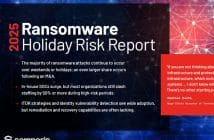
Trellix has released global research revealing Australian businesses are being inundated by cybersecurity incidents, dealing with an average of over 55+ alerts daily – the highest average in the Asia Pacific region. According to the research of cybersecurity professionals, including 1,000 from Australia, 60% of respondents feel like they’re losing ground against cybercriminals. This comes as security operations (SecOps) teams are faced with “siloed” security tools, exposing weak spots in protection and lack of confidence in their organisation’s ability to adapt to new and evolving threats.
Australian SecOps teams are facing multiple hurdles
Impacted by ongoing challenges with siloed security, 61% of cybersecurity professionals admit their current security tools don’t enable their SecOps team to work with maximum efficiency. Only 35% recognise they have blind spots in their protection today. Failure to consolidate tools impacts efficiency and can hinder detection, response, and remediation capabilities of these teams, reducing the overall effectiveness of cybersecurity strategies.
The research also revealed 62% of cybersecurity professionals are working with more than ten different security tools/solutions across their business right now, with more than 20 tools for 6% of respondents, highlighting a greater need for integration across businesses.
Australian businesses are also feeling the pinch, with 85% or respondents reporting their business has lost up to 10% revenue due to security breaches in the last 12 months.
Despite all of this, more than half (54%) of respondents recognise the need for their security models to be updated in order to predict, detect and respond to cybersecurity incidents in real time.
“What Australian organisations must realise today is that siloed security models are a catalyst for inefficient cybersecurity protection and can consequently impact their bottom line,” said Vicki Batka, Senior Vice President, Asia Pacific and Japan at Trellix. “It is clear from our research that SecOps teams need support to help them combat the growing and relentless attacks we see from cybercriminals. Introducing open security architecture will assist these teams, helping them to learn and adapt to new threats in real time. A core competency of XDR is to deliver greater operational efficiency and quicker remediation of threats, ridding businesses of their reliance on disjointed systems.”
The state of XDR adoption in Australia
According to the research, a quarter (25%) of respondents have already implemented XDR in their business, with an additional 42% saying it is very likely they will also implement XDR in the next 12-18 months.
Of those respondents who have already implemented XDR in their organisation, over half (53%) feel the ability to automate processes and prioritise critical concerns is one of the most important benefits, followed by real time detection (58%), operational efficiency (48%), adaptive security (39%) and quick remediation (39%).
The study, based on research conducted by Coleman Parkes, surveyed 9,000 cybersecurity decision-makers from organisations with 500 or more employees across fifteen markets: Australia (1000 respondents), Brazil, Canada, Chile, Colombia, France, Germany, India, Indonesia, Mexico, Singapore, South Africa, UAE, the UK, and the USA.
You can read the full report here.





